#Ashoka Emblem
Explore tagged Tumblr posts
Text
So about Sabine Wren
When we see her in the Ashoka Teaser:

(Brilliant casting, wonderful hair, and costume design)
She isn't wearing armor.
And sure, she's not in combat, the war is over, but Sabine isn't a soldier, she's a Mandalorian.
Mandalorians are a people, children of Mandalor. That's why Bo-Katan calls Din 'brother' when she first meets him and refers to the rest of the Mandlorians as her brethren. (This is a basic translation of 'vod' meaning brother, sister or comrade in the way you might call a friend bro or sis.)
Mandalorian is a religious and cultural identity. The Resol'nare is the six core actions that are the heart of her culture/religion:
Wearing armor.
Speaking the language.
Defending yourself and your family.
Raising your children as Mandalorians.
Contributing to the clan's welfare.
When called upon by the Mand'alor, rallying to their cause.
Wearing armor is number 1. Some factions interpret number 1 as never remove your helmet in front of others.

Most interpret it as wearing armor and removing your helmet where practical.

(look, it's Sabine's mom)
Even Mandalorians who are not practicing, but are Mandalorian by Leniage will still wear armor. Not just because Beskar Armor is amazing, but because armor connects the wearer to their family who passed it down to them.

"The armor I wear is 500 years old. I reforged it to my liking, but the battles, the history, the blood, all lives within it, and the same goes for every Mandalorian. This armor is part of our identity. It makes us Mandalorians who we are." - Sabine
For those born Mandalorian, their armor is a priceless heirloom. Foundlings who are not adopted into a family that can pass down armor are gifted extra pieces of armor by the entire community. Every scrap is sacred and goes to someone, it either connects you to your family, history, and blood or to everyone's family, history, and blood as part of the greater family of Mandalorians.
We've seen Sabine without her armor before, when going undercover she's worn imperial uniforms, but it is strange to see her forgoing beskar by choice.
I love how the design uses patches where she had emblems on her armor (I did that for my Disney Bound of her). It's very thoughtful costuming. So what is the meaning behind having her wear a leather jacket (Ezra's Jacket?) and forgo armor.
Has she exiled herself for not being there during the purge?
Sabine was estranged from her birth family during Rebels, but her birth family and people remained a core part of her identity and motivation.
youtube
In this scene, her adoptive Jedi father teaches her to wield the Dark Saber and to connect to her emotional truth.
"The truth... is that... I left to save everyone. My mother, my father, my brother! Everything I did was for family, for Mandalore!"
Joining the rebellion was for Mandalor and to atone for the harm she had done to her people while at the Imperial Academy (her system was imperially controlled, it was expected that she join, and she was a prodigy who joined young)
"I built weapons, terrible weapons, but the Empire used them on Mandalore, on friends, on family. People that I knew. They controlled us through fear. ( Scoffs ) Mandalore! Fear of weapons I helped create. I helped enslave my people! I wanted to stop it. I had to stop it. I spoke out! I spoke out to save them. To save everyone!"
In Rebels Sabine clearly identifies as a Mandalorian and that's an important part of her identity.
You can't tell she's a Mandalorian in the top photo, perhaps because she no longer believes she deserves to be one.
As shown above, her family and people are the most important thing to her. She left her found family to reunite with her birth family and found a rebellion on Mandalore which she led. However, after fighting alongside Bo-Katan Sabine felt that Bo-Katan should be leader.
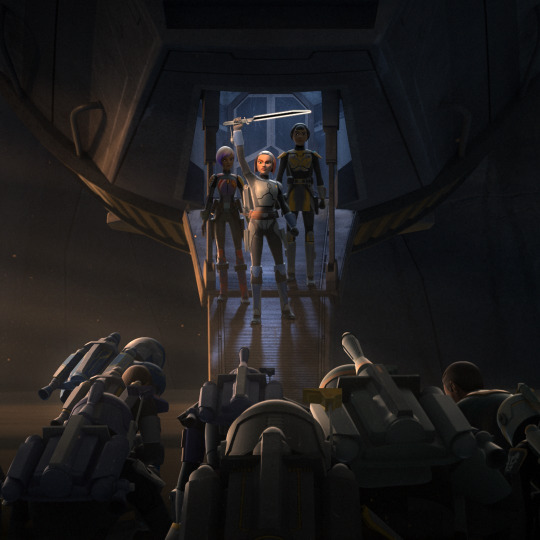
(And so did everybody else, Bo-Katan was heir by blood but she was for all intents and purposes elected leader by popular consent)
Sabine then left to return to the Rebel Alliance and fight alongside her found a family in their rebel squadron and remained with them to safeguard Lothal.
Sabine left the Mandalorian Rebellion. She was not there when the rebellion failed. When the Empire set out to destroy her planet and kill everyone on it. She is a survivor of genocide and was not with her people fighting when it happened. Worse, the genocide was a response to a rebellion she started but was not there to see through.
It's not her fault. It's not any Mandalorian's fault.
But how must she feel?
Now recall the Resol'nare: half of the six core actions are about family, clan, and people.
Defending yourself and your family.
Contributing to the clan's welfare.
When called upon by the Mand'alor, rallying to their cause.
Sabine was not there to defend her family or contribute to her clan's welfare. She was not with Bo-Katan, the Mand'alor, she put in power, to help.
Perhaps Sabine no longer wears her armor because she no longer feels worthy of being a Mandalorian.
When Ahsoka sees her on Lothal Ahsoka is in gray robes like she wore in the Mandalorian.

In the Rebels epilogue Ahsoka is in white.

Sabine also looks different in this scene:

Sabine could not have grown her hair to the length in the Ahsoka trailer if that scene took place after the Rebels epilogue. However, she could easily crop her hair short between the trailer scene and the epilogue.
She's also wearing her armor again. Maybe when we first meet Sabine in Ahsoka we will see her in a darker place. She's given up on being a Mandalorian. She's grown her hair out in mourning. Maybe Ahsoka gives her hope, so she puts on her armor again and cuts her hair short, symbolically shedding the weight of grief and guilt.
174 notes
·
View notes
Note
What do you think about the blue haired guy being King Ashoka?
seems interesting! i admittedly know a lot less about him than i do the mahabharata-era characters but his emblem is actually used even today as the emblem of india and his wheel is the symbol you see on the indian flag


(the statue on the left is the lion capital of ashoka, erected after he converted to Buddhism to commemorate the site of buddha's first sermon)

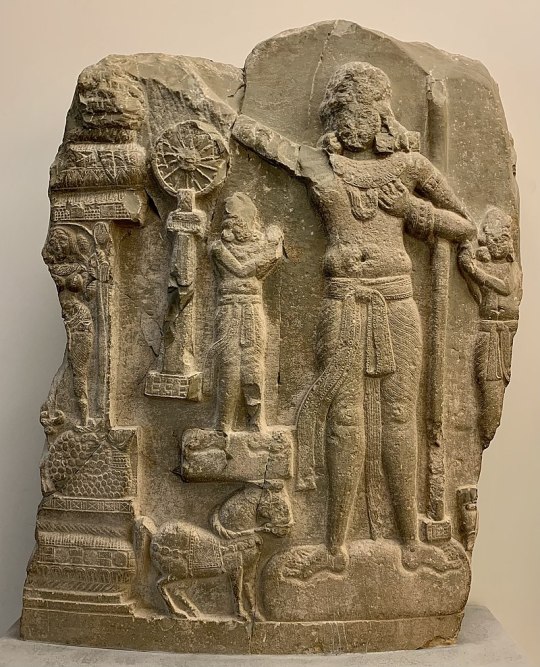
the wheel of ashoka as designed for the indian flad and an example of how it (possibly) appeared in antiquity
he's definitely an interesting character although I am not at all sure what direction fate will take him in, as even just from browsing his wikipedia page it seems like his cruelty prior to conversion sometimes gets overemphasized to make a point about his piousness afterwards
#admittedly a hair bummed bc i really wanted another mhbrt guy but im not upset at him#he does seem neat#he has a...interesting history#only downside is he's very buddhist and we know how fate is abt that#my asks#also got these images off wikipedia fyi
12 notes
·
View notes
Note
HELLO
5, 10, 13, 15, 18, 19, 21, 29 from here
(i just realised that that's a lot so feel free to skip some/answer selectively if you want to do that!)
CAL HIIIII!!!!
(are you kidding ofcourse I'm gonna answer all of that, let's make a game out of it and see how long it takes me)(it's 15:05 when I started answering)
5. Favourite song in your native language
Can't think of one rn😭 The first one that came to mind is Venmadhi Venmadhi from Minnale because some guy was playing that on the bus yesterday. I think it's a lovely song, especially the third verse :)
10. Most enjoyable swear word in your native language
I don't really swear in Tamil😂 I only use words like stupid/wastrel/dog/buffalo... y'know the most common ones lol
But, again, the first swear word that came to mind is *looks around to make sure no one's listening* "watha" - which is basically the Tamil equivalent of fuck - because one of my friends called another friend that this morning lmao
13. Does your country (or family) have any specific superstitions ot traditions that might seem strange to outsiders?
Well there's so many but i generally think that doing rituals/ chanting slokas or vedas must be very strange to outsiders who aren't really used to that! Imagine being a white christian and you encounter a yagna happening with a giant fire, lots of huge shirtless men saying very weird words in their blaring voice, adding all kinds of different things into the fire, while surrounding people watched on... I'd be terrified 😂💀
15. A saying, joke, or hermetic meme that only people from your country will get?
SO BEAUTIFUL. SO ELEGANT. JUST LOOKING LIKE A WOW.
18. Do you speak with a dialect of your native language?
Gosh I speak so many dialects - depending on who I'm talking with. There's what I consider the normal one, there's the one mixed with random English sentences😂, there's the local chennai dialect for when I'm dealing with/in public or local vendors💀, there's the tambrahm (wow it feels weird to say it like that) dialect because that's what I was raised on in mum's side of the family
19. Do you like your country's flag and/or emblem? What about the national anthem?
I've honestly never thought about this before...
Flag - 🇮🇳 It's a good one, I like what it stands for. But no one would forget the struggle it would take when you were 6 years old and were asked to draw the national flag and you wouldn't remember how many spokes are there in the ashoka chakra😭 or even if you remembered, you wouldn't know how to divide them evenly throughout the circle... So much stress. 7/10
Emblem - it's a bit complex if you ask me but eh. It looks cool i guess. I like the phrase 'satyameva jayathe' ("truth alone triumphs" in Sanskrit) so there's that :p 5/10
National Anthem - I love it!! I like the picture it paints, listing out all those places! Only criticism is that it was very difficult for younger abi to sing the beginning because it was so very low and i struggled for a long time😅 9/10
21. If you could send two things from your country into space, what would they be?
Aloo mutter gravy and methi roti👍
29. Does your region/city have a beef with another place in your country?
I was thinking really hard...before i realised🤭
MYSURU. WHY do you do that to your sambar??? It's nice, I'd be lying if I said it's bad, but how?????? How did you come to the decision "oh you know what. I'm gonna make this taste sweet. Yeah."??
We went to Mysore one time and had some sambar and do you know what happened, cal? My cousin threw up, that's what happened.
(it was because of the long uphill travel but the sambar definitely contributed :p)
What you lack in sambar, you make up for it with Udupi rasam so. I forgive you😤
(now the time is 15:55)
"Hi, I'm not from the US" ask set
12 notes
·
View notes
Text
Chandrayaan 3: Pragyan rover comes out of Vikram lander, walks on Moon, ISRO shares video

Chandrayaan 3: The Indian Space Research Organisation (ISRO) has released the much-anticipated video of the Pragyan rover ramping down from the Vikram lander and walking on the lunar surface.Pragyan rover coming out of Vikram lander
The rear wheels of the rover, have imprints of the space agency ISRO and the Indian emblem, depicting the Lion Capital of Ashoka at Sarnath. Faint marks can also be seen in the first video shared by the Indian space agency.
Chandrayaan-3 mission detailed timeline
Here is the detailed timeline of all the developments in the Chandrayaan 3 mission.
• July 6: ISRO announces Mission Chandrayaan-3 launch date of July 14 from Sriharikota's second pad.
• July 7: Successful vehicle electrical tests completed.
• July 11: Comprehensive 24-hour 'Launch Rehearsal' simulating the entire launch process concludes.
• July 14: LVM3 M4 vehicle launches Chandrayaan-3 into designated orbit.
• July 15: First orbit-raising manoeuvre successful, reaching 41762 km x 173 km orbit.
• July 17: Second orbit-raising manoeuvre places Chandrayaan-3 at 41603 km x 226 km orbit.
• July 22: Fourth orbit-raising manoeuvre establishes spacecraft in 71351 km x 233 km orbit.
• July 25: Another successful orbit-raising manoeuvre.
• August 1: Chandrayaan-3 inserted into translunar orbit (288 km x 369328 km).
• August 5: Successful lunar orbit insertion (164 km x 18074 km).
• August 6: Lunar orbit lowered to 170 km x 4,313 km.
• August 9: ISRO carefully moves the spacecraft's path lower in its orbit around the moon. It has achieved a lunar orbit of 174 km x 1437 km
• August 14: Chandrayaan-3 gets closer to the moon's surface in another controlled bringing it in a orbit of 150 km x 177 km
• August 16: The Indian spacecraft performs the fifth and final Moon-bound manoeuvre positioning itself in a near circular Lunar orbit of 163*153 km.
• August 17: The landing module, comprising the Vikram lander and Pragyan rover, gets separated from its propulsion system.
• August 18: Chandrayaan 3 successfully completed a 'deboosting' operation that reduced its orbit to 113 km x 157 km
• August 20: The Chandrayaan-3 will make the final orbit adjustment by reducing it to be around 134*25 km, the farthest and nearest point from the moon respectively.
• August 23: ISRO marked history with the successful landing of the Vikram lander. All the systems are performing as intended.
for more information: khabri
2 notes
·
View notes
Text
ART OF ODISHA
ART OF ODISHA
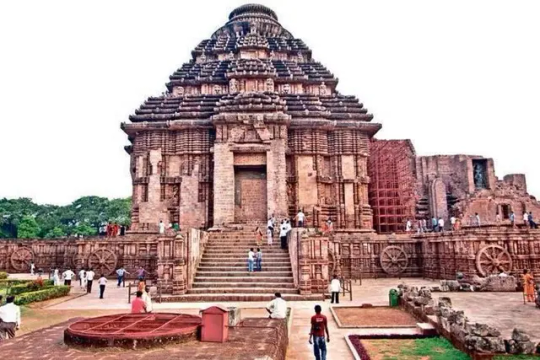
The Rock Art of Odisha dates back to as early as the prehistoric period. The earliest reported are the rock shelters of Vikramkhol in Jharsuguda district. The cells attracted men to live there, who decorated these rock shelters with paintings and engravings in various geometrical forms and figures of human and animals.
HERE ODISHA HISTORY BOOK AVAILABLE
Most of these sites are found in the hills of Sundergarh, Jharsuguda, Sambalpur and Kalahandi. The rock edicts at Dhauli, Jaugad and the archeological treasures found at excavation sites of Sisupalgarh testify to the earliest highly developed sculptural art of Orissa covering a period of about 2000 years.
The forepart of an element, hewn out of solid rock at Dhauli represents the earliest sculpture in Odisha. With the rise of Kharavela (Chedi dynasty) in the first century BC caves were ordered to cut in the solid rocks for the use of Jain ascetics. The caves of Khandagiri and Udayagiri decorated with highly artistic large panels depicting a vivid picture of the contemporary society find special mention in the rock cut architecture of India.
Figures of Jain tirthankars and Sasanadevas with their emblems have been found in caves in Puri, Keonjhar, Balasore and Koraput districts. The caves consist of one or more cells and a few of them are fronted by pillared verandahs.
The Buddhist sculptural art developed with Emperor Ashoka from 261 BC to about 12th Century AD. With the transforming of Mahayana form of Buddhism to Vajrayan, the creative genius of the artists once again attained its peak as reflected by Buddhist sculptures of Lalitgiri, Udayagiri and Ratnagiri.
Sculptures representing Boddhisatva and Avalokiteswara in different forms along with Buddha images, stupas and monasteries were the main constituent of the early medieval Odishan sculptural art.
However, the art found its supreme expression represented by the sculptures pertaining to various sects of Hinduism in Orissa, the Saivism, Vaishnavism and Shaktism (represented by Durga and her different forms). The Sailodbhava, the Bhaumakaras, the Somavansis and the illustrious Gangas are particularly known for temple building. The sculptures and superb carvings on the temples at Bhubaneswar, Puri and Konark are the finest examples of the Odisha��s glorious past.
Look out for the sculptures of nayika and mithuna figures, yakshas and yakhis (the male and female deities associated with ancient fertility cults), heavenly musicians, human poses and expressions, elephants, horses and soldiers and those depicting day to day themes, like hunting, dancing, games and family life. After the fall of the Gangas, sculpture in Odisha vanished as an art form.
2 notes
·
View notes
Text
Dasain 2024 (Banaras, Hyderabad, Mumbai)
October 09, Wednesday (Day 1) Flight from Kathmandu to Varanasi at 7:15am At airport Channi Didi’s parents (Piku Uncle and Aunty there) to see her and Kavi Check in at Taj Ganges Varanasi Breakfast at Ram Bhandar (Poori Bhaaji) Sweta didi comes to hotel Drive around BHU campus, see Papa’s hostel Gurtu, Birla Mandir, Sanktmochan Hanuman Chaat at Deena Chaat (really tasty, especially the Gulab Jamun) Go towards Ghaat for Boat ride Evening Aarti and boat ride Dinner at Vatika Pizzeria by Assi Ghaat (yummy Applie pie)
October 10, Thursday (Day 2) Morning visit to Kashi Vishvanath Temple Chana kachori nearby and also Lakshmi Chaiwala Chaai and Toast Go to Sarnath and take a tour of the archaeological site, mediate there, go to the museum and see the original Ashoka Pillar India Emblem Capital Chill in Swimming Pool Visit Piku Uncle house Dinner at Baati Chokha with Piku Uncle
October 11, Friday (Day 3) Chill at Cafe Mangi Ferra Eat at Kashi Chaat Start our Street Tour (through bylanes, Lakshmi Chaiwala, Blue Lassi, Pashupati, Kashi Vishwanath corridor) Chill at Hotel Brijrama Take boat to Guleria Kothi and have Indian food there Kaal Bhairav Mandir darshan Back to hotel-meet with Sagun (Anil Mamaji’s relatives daughter) and her husband Umang
October 12, Saturday (Day 4) Akaasa Air flight from Varanasi to Hyderabad. Sweta didi flying to Kolkata Andhra Thaali lunch at Southern Mirchi Check in at Taj Krishna Drive around Go to The Quorum at Knowledge Park to play pedal-ball Drive then metro to go to Uppal Rajiv Gandhi Stadium to watch India vs Bangladesh match. India makes it’s highest T20 score and second highest ever (297 runs)
October 13, Sunday (Day 5) Breakfast at hotel Round Table brunch with Jijus round table friends, us and Amogh Off the shelf bookstore. Sunita Mamiji we meet here Gelato from Roast Jiju showed us his Housing Colony: Trail Dinner at Akshat Jiju and Sachi didi’s place (Sunita Mamiji, Ayush, Sachi Didi, Jiju, Arjun Bhaiya, Sonali Bhabi and Uncle, Aunty) Akshat Jiju drove us around the city
October 14, Monday (Day 6) Yoga with Amogh Breakfast at Nani’s Nap at hotel Lunch at Roast and Tour of their facilities Madhu Mausi’s place Dinner at Madhu Mausi and Mausaji’s restaurant
October 15, Tuesday (Day 7) Check out of hotel Dosa and Idli at Panchakattu Dosa Tour around Amazon Office with Bhaavya Go to Silent Studio for floatation in the dark Nilofuer Cafe with Sachi didi, Nirvaan and Aayush Anu Mausi’s place for dinner and leave for airport (Amogh drops) Flight from Hyderabad to Mumbai Hang out at Tulja’s place with Tullu and Ankur while we wait for Didi and Jiju to come from Kolkata
October 16, Wednesday (Day 8) Breakfast at Didi’s place Work from home Lunch at Didi’s place Go for drive and have cold coffee and then sevpuri and bhelpuri at Altamount Road Came home for online meeting Dinner at Americano in Fort Drive around
October 17, Thursday (Day 9) Global Vipassana Pagoda (Museum, 1-Day course) Hang out at Tulja’s place and order in food
October 18, Friday (Day 10) Shashi Mausi comes to meet Pooja Bhua’s house Bina Bhua’s house Pick up Mansi and Didi and go to Right Place for sandwich Mansi showed NSCI Club Coffee with Didi and Mansi at Cafe Eve Chill at home Breach candy Club with Namita Didi and Pratik Jiju. Ran into Anu Aga and her daughter (Thermax)
October 19, Saturday (Day 11) Go to Vaibhav to meet. Kunal Bhaiya/Priyanka Bhabi/Bhuaji/Fufaji/Shivani Didi/Shikha Bhabi/Extended family Coffee at Greenr with Sweta Didi Comedy show Aakash Gupta at Shanmukhananda Auditorium Snacks at Gurukripal Surya Hospital for Tulja’s delivery Baby Girl born Go to Raju ki Chaai for late night snacks
October 20, Sunday (Day 12) Work from home Go to hospital to meet Tulja and Baby Ayush Bansal/wife Nikita and daughter Avyaa also met. Seeing Ayush probably after 10 years if not more Chaat at Elco Market Drive around Juhu/Bandra Take DreamTrust call from car Didi had her first Karwa Chauth so ritual in terrace and dinner at home
October 21, Monday (Day 13) Marina Hotel went to the coffee shop Bay Leaf with Sweta didi to just talk Lunch at Pizza by the bay Gelato from Comm Walk around grocery store Benzer Go to Boojee Cafe in Bandra with Didi and Ayush Surya Hospital to see Tulja and Baby Karuna Naniji and Nanajis house in JB Nagar to meet them Dinner at Prithvi Cafe with Ayush, Ankit, Ishu, Ankur, Didi Shiv Sagar for rose falooda Back home
October 22, Tuesday (Day 14) Ujjawal Jiju and Didi came to drop me to the airport Hung out in airport with Ayush Mumbai to Kathmandu flight
0 notes
Text
Tiranga Game A Celebration of Unity and Heritage

The Tiranga Game is a dynamic and engaging activity that resonates deeply with the spirit of India, symbolized by its national flag. The term "Tiranga" translates to "tricolor" in Hindi, reflecting the three horizontal stripes of the Indian flag: saffron, white, and green. This game is more than just a recreational pursuit; it is a celebration of cultural pride, patriotism, and community spirit. This article explores the origins, significance, rules, and broader impact of the Tiranga Game, highlighting its role in fostering national identity and unity.
The Symbolism of the Tiranga
The Indian national flag is a powerful emblem of the country's journey towards freedom and self-determination. Each color in the flag holds significant meaning: saffron symbolizes courage and sacrifice, white represents peace and truth, and green stands for faith and chivalry. At the center of the flag is the Ashoka Chakra, a 24-spoke wheel that signifies the eternal wheel of law and dharma.
The Tiranga serves as a daily reminder of the sacrifices made by countless individuals during the struggle for independence. When the flag is hoisted, it evokes a sense of pride, responsibility, and patriotism among citizens. The Tiranga Game transforms these values into a fun and interactive format, encouraging participants to engage with their heritage while fostering a sense of belonging.
Historical Context and Origins of the Tiranga Game
The precise origins of the Tiranga Game are not well-documented, but its rise in popularity can be traced back to the growing emphasis on patriotic activities during national festivals, particularly Independence Day and Republic Day. Schools, community organizations, and local clubs have adopted the game as a means to engage people, especially the youth, in activities that promote national pride.
The Tiranga Game serves multiple purposes: it educates participants about India's history and the values represented by the flag, while also providing a platform for creative expression and physical activity. Over the years, it has evolved into a beloved tradition that helps deepen individuals’ connections to their national identity.
The Format of the Tiranga Game
The Tiranga Game is highly adaptable and can be tailored to fit various settings, from schoolyards to community festivals. The primary objective is to promote teamwork, sportsmanship, and cultural appreciation while celebrating the spirit of unity among participants.
Basic Rules
Team Formation: Participants are typically divided into three teams, each representing one of the colors of the national flag: saffron, white, and green. This division fosters a sense of camaraderie and belonging.
Game Variations: The Tiranga Game can incorporate a variety of activities, such as:
Relay Races: Teams compete in races, passing a baton or flag to one another.
Obstacle Courses: Participants navigate through challenges that test their agility, speed, and teamwork.
Cultural Quizzes: Teams answer questions related to Indian history, culture, and the significance of the flag.
Art and Craft Activities: Teams can engage in creating art that represents their interpretation of the Tiranga, fostering creativity.
Cultural Attire: Participants are encouraged to wear clothing that reflects the colors of the flag. This adds to the festive atmosphere and reinforces the theme of unity and national pride.
Scoring and Prizes: Points are awarded based on performance in various activities. Celebrating winners at the end of the event emphasizes that while competition is important, the true spirit of the game lies in participation and unity.
The Role of Creativity
One of the most exciting aspects of the Tiranga Game is its potential for creativity. Participants can design their own activities or incorporate local traditions, allowing for a rich variety of cultural expressions. This creativity not only enhances the enjoyment of the event but also helps preserve regional customs and practices, making each game a unique reflection of the local community.
The Significance of the Tiranga Game
Fostering Unity and Inclusion
In a country as diverse as India, the Tiranga Game serves as a powerful unifying force. It brings together individuals from different backgrounds, languages, and cultures under a shared identity. The game promotes teamwork and collaboration, nurturing a spirit of inclusivity and harmony. By participating in the Tiranga Game, individuals can transcend their differences and celebrate their common identity as citizens of India.
Educational Value
The Tiranga Game is not only entertaining but also educational. Through quizzes and challenges, participants learn about the significance of the Indian flag, its history, and the values it represents. This educational component reinforces the importance of patriotism and civic responsibility, particularly among younger generations. By learning about their nation’s history and cultural heritage, participants are encouraged to take pride in their identity.
Promoting Physical Fitness and Well-being
Physical activity is essential for maintaining health and well-being. The Tiranga Game encourages participants to engage in active play, fostering a love for sports and outdoor activities. This emphasis on physical fitness contributes not only to improved health but also to mental well-being. Engaging in social interactions during the game enhances mood and fosters positive relationships among participants.
Celebrating Cultural Heritage
The Tiranga Game is a vibrant celebration of India’s rich cultural heritage. By incorporating traditional games, folk music, and dance, participants gain a deeper appreciation for the diverse cultural landscape of the nation. This celebration of heritage is crucial in an age where globalization often threatens to dilute local customs and traditions. The Tiranga Game allows communities to come together, share their cultural expressions, and promote a sense of belonging.
The Future of the Tiranga Game
As the Tiranga Game continues to grow in popularity, numerous opportunities for its expansion and evolution arise. Schools and organizations can introduce annual tournaments that incorporate technology and social media to reach a broader audience. By sharing experiences online, the game can inspire more people to participate and engage with their national identity.
International Recognition
The potential for the Tiranga Game to gain international recognition is promising. As a symbol of unity and cultural pride, it could serve as a model for similar initiatives in other countries, promoting peace and cooperation through sports and cultural exchange. By participating in international events, the Tiranga Game can showcase India’s diverse culture and heritage to the world.
Environmental Awareness
Incorporating elements of environmental awareness into the Tiranga Game can enhance its relevance in today’s world. Activities focused on sustainability, such as tree planting or recycling challenges, could align the game with global efforts to combat climate change. This holistic approach would make the Tiranga Game not only a celebration of national pride but also a platform for promoting responsible citizenship and environmental stewardship.
Conclusion
The Tiranga Game is more than just a recreational activity; it embodies the spirit of India—its history, culture, and values. By engaging individuals of all ages in a celebration of unity and heritage, it fosters a deeper understanding of what it means to be part of this diverse nation. The game serves as a powerful reminder of the bonds that tie us together as citizens of India, inspiring participants to carry forward the values represented by the national flag.
As we continue to embrace and promote the Tiranga Game, we honor our past while paving the way for a future filled with shared dreams, aspirations, and the enduring spirit of togetherness. Whether played in local parks, schoolyards, or large public gatherings, the Tiranga Game remains a dynamic celebration of unity, patriotism, and cultural heritage. It encourages us to come together, celebrate our differences, and foster a collective identity rooted in pride and responsibility toward our nation. The spirit of the Tiranga will live on in every heart, guiding us toward a brighter, united future.
1 note
·
View note
Text
Places to Visit in Bhubaneswar: A Complete Guide for Travelers
Bhubaneswar, the capital city of Odisha, is a treasure trove of ancient temples, modern architecture, and vibrant culture. Known as the City of Temples, it offers visitors a perfect blend of heritage and modernity. Whether you're a history enthusiast, nature lover, or spiritual seeker, Bhubaneswar has something for everyone. In this guide, we’ll take you through some of the top places to visit in Bhubaneswar, and how cab booking Bhubaneswar services can enhance your travel experience.

1. Lingaraj Temple: A Spiritual Marvel
The Lingaraj Temple is one of the most prominent attractions in Bhubaneswar, known for its architectural grandeur. This 11th-century temple dedicated to Lord Shiva is a remarkable example of Kalinga architecture. The main tower rises to a height of 180 feet, dominating the skyline. The temple complex consists of 50 smaller shrines, all exuding serenity and devotion.
For visitors, taking a Bhubaneswar taxi is one of the most convenient ways to reach the Lingaraj Temple. With well-trained drivers and seamless cab booking Bhubaneswar services, you can explore the temple without any hassle.
2. Udayagiri and Khandagiri Caves: Ancient Wonders
Located just a few kilometers from the city center, the Udayagiri and Khandagiri Caves are a must-visit for history buffs. These caves, dating back to the 1st century BCE, are believed to have served as the residence of Jain monks. The intricately carved caves are divided into two clusters, Udayagiri (meaning "sunrise hill") and Khandagiri (meaning "broken hill"), each telling a story of spiritual austerity.
To make your visit to these caves more convenient, hiring a taxi in Bhubaneswar is the ideal choice. The roads leading to the caves are scenic, and traveling by a comfortable Bhubaneswar cab can elevate your experience.
3. Dhauli Shanti Stupa: Emblem of Peace
Situated on the banks of the Daya River, the Dhauli Shanti Stupa stands as a symbol of peace and tranquility. Built atop Dhauli Hill, this stupa commemorates the location where the infamous Kalinga War took place. The transformation of Emperor Ashoka from a conqueror to a messenger of peace after witnessing the war’s devastation makes Dhauli a site of historical significance.
Reach this peaceful sanctuary by booking a cab in Bhubaneswar. Reliable cab services ensure you can enjoy the panoramic views and the peaceful surroundings at your own pace.
4. Nandankanan Zoological Park: A Treat for Nature Lovers
Nandankanan Zoological Park is a well-known wildlife reserve that houses some of the most exotic species of flora and fauna. Sprawling across 400 hectares, it is home to white tigers, Asiatic lions, and a variety of other rare species. The botanical garden located nearby adds another layer of attraction for nature lovers.
Families and nature enthusiasts can make use of Bhubaneswar taxi services for a comfortable journey to the park. The ease of cab booking Bhubaneswar means you can plan your day with flexibility and freedom.
5. Odisha State Museum: A Dive into History
For those interested in exploring the history and culture of Odisha, a visit to the Odisha State Museum is a must. The museum houses an extensive collection of ancient manuscripts, weapons, archaeological artifacts, and coins that give a comprehensive view of the state's rich heritage.
The museum is located in the heart of Bhubaneswar, and hiring a Bhubaneswar taxi is an excellent way to reach it. Exploring the museum with the convenience of reliable Bhubaneswar cab services can make your visit more enjoyable and relaxed.
6. Ekamra Kanan Botanical Gardens: A Green Retreat
Amidst the urban buzz, the Ekamra Kanan Botanical Gardens provide a peaceful retreat for those who love nature. The garden, spread across 500 acres, is filled with various species of plants and offers a delightful environment for morning walks and picnics. The rose garden and cactus house are major attractions within the park.
Travelers can easily reach this serene park by using cab services in Bhubaneswar. With plenty of parking and easy accessibility, Bhubaneswar cabs offer a convenient solution for families and tourists alike.
7. Mukteswara Temple: Jewel of Kalinga Architecture
The Mukteswara Temple, dedicated to Lord Shiva, is often referred to as the "Gem of Odisha" for its intricate carvings and stunning architecture. Built in the 10th century, this temple is one of the most finely carved temples in Bhubaneswar. Its Torana, or gateway, is a standout feature, making it one of the most visited places in the city.
A taxi in Bhubaneswar can take you directly to the temple, ensuring a comfortable journey. Using cab services in Bhubaneswar allows you to explore this architectural masterpiece without the stress of public transportation.
8. Rajarani Temple: An Architectural Delight
One of the most beautiful temples in Bhubaneswar, the Rajarani Temple stands out for its unique design and lack of any presiding deity. Built in the 11th century, it is often referred to as the "Love Temple" because of the many carvings of couples and celestial beings on its walls. The blend of Nagara architecture and the artistic finesse of this temple makes it a must-visit for art lovers.
Taking a Bhubaneswar taxi will make your visit to the Rajarani Temple more comfortable and time-efficient. With cab booking Bhubaneswar services, you can explore the city’s rich cultural sites at your leisure.
9. Pathani Samanta Planetarium: A Space Odyssey
For those who have a keen interest in astronomy, the Pathani Samanta Planetarium is an excellent destination. It offers educational shows and exhibitions about space, celestial bodies, and the universe at large. A visit here is especially exciting for children and space enthusiasan reach the planetarium with ease. With professional drivers who know the best routes, your trip will be smooth and enjoyable.
10. Bindusagar Lake: Serenity in the Heart of the City
Located near the Lingaraj Temple, Bindusagar Lake is one of the larts.
Booking a cab in Bhubaneswar ensures you cgest water bodies in Bhubaneswar. The lake is not only a popular pilgrimage site but also a tranquil spot to relax and unwind. Local legends suggest that the water in the lake is a mixture of water from various sacred rivers of India.
Bhubaneswar taxi services provide an easy way to reach the lake, making it a stress-free addition to your city exploration. Whether you’re visiting for religious purposes or a quiet evening by the lake. Bhubaneswar offers a wide range of experiences that cater to all kinds of travelers, from historical landmarks to natural retreats. Navigating through these incredible attractions becomes all the more enjoyable when you rely on cab booking Bhubaneswar services. With the flexibility, comfort, and professionalism that Bhubaneswar taxi and cab services offer, your journey through this magnificent city will be unforgettable.
0 notes
Text
Planning your Trip? What is the Best Time to Visit Darjeeling for Stunning Views

Darjeeling is located in West Bengal and is among the slopes of the Himalayas. It is a popular hill station and is known for its lavish green tea plants and scenery. When it comes to vacationing in India, Darjeeling is the top location because there are countless sites to discover and the best time to visit Darjeeling is around March or April. Ashoka Holidays has an experience of more than 20 years in offering customized holidays for a unique experience.
Witness the proper vacation in Darjeeling
The weather is generally clear, while there is occasionally a danger of hailstorms and high winds. This is the ideal time of year to visit Darjeeling because of the cool to pleasant temperatures. As June approaches, the weather usually becomes very hazy with the possibility of rain. Be aware that if you’re driving, this can be a difficult time to maneuver. On a more positive side, the offseason has begun. Because of this, there won’t be as many people and the costs will be lower.
Major Indian cities are well-connected to Darjeeling via rail and road. About 96 kilometers away, Bagdogra, is the closest airport. To get to Darjeeling from there, you can either take a shared taxi or rent a car. An additional well-liked route to the hill station is the Darjeeling Himalayan Railway, popularly referred to as the Toy Train. Visitors may enjoy a variety of attractions and activities in Darjeeling. You may take in the mouthwatering Konkani food, experience the local markets, visit the historic temples, and unwind on the immaculate beaches.
Sightseeing in Darjeeling
Batasia Loop: A War Memorial dedicated to the Gorkha soldiers of the Indian Army who fought for independence is located near Batasia Loop, offering scenic views of the surrounding valleys and mountains. From Batasia Loop, you can enjoy a 360-degree view of Darjeeling town and Mount Kanchenjunga. Also, the best time to visit Darjeeling for snowfall is December to February which is admirable through Batasia Loop.
Japanese Peace Pagoda: The Japanese Peace Pagoda, which is perched on the slopes of Jalaphar Hill and features the four Buddha avatars, including Maitreya Buddha, is a universal emblem of peace. Japanese Peace Pagoda is the tallest building in Darjeeling, measuring around 28 meters in height. It is one of the best places to visit in Darjeeling with a blend of ethnic avatars.
Tiger Hill: Kanchenjunga’s summits light up before daybreak, appearing before the sun does in lower altitudes. Tiger Hill gives a great view of Mount Everest which is the Earth’s highest mountain above sea level. Get a wonderful view of snow-capped mountains which attracts the tourist to the magnificent place. It is the of highest railway station in Darjeeling.
Ghoom Monastery: A five-year statue of Maitreya Buddha which is also called “The Buddha to Come” is kept at the Ghoom Monastery. This is the one of the best places in Darjeeling to visit which allows the curiosity of the visitor.
Dhirdham Temple: The Dhirdham Temple has different elements and the great statue of Lord Shiva which shows his third eye and different expressions of the god with different contexts. This temple has a lot of trust of people where visitors come from long way to make their prayers effective.
Learn More…
#best tours and travels in india#tour 2024#Dhirdham Temple#darjeeling tour package#darjeelingdiaries#Darjeeling
0 notes
Text
Predicting the Future of the Tiranga: Colors and Symbolism in a Changing India

As we look forward into the future, the colors of the Tiranga—the Indian tricolor flag—remain a potent symbol of India’s values, identity, and aspirations. The Tiranga, with its vibrant hues of saffron, white, and green, and its iconic Ashoka Chakra, is more than just a flag. It represents the rich tapestry of India’s history, culture, and democratic spirit. But what does tiranga color prediction future hold for these colors, and what might they come to symbolize as India continues to evolve.
Saffron: Embracing Change with Tradition
The saffron stripe of the Tiranga signifies courage and sacrifice, and it has been a color deeply rooted in Indian tradition and spirituality. In the future, this color might continue to represent the country's enduring strength and commitment to justice and equality. As India progresses technologically and economically, saffron could evolve to symbolize the nation's courage in facing new challenges—be it in terms of innovation, environmental sustainability, or social reform.
As India becomes a global leader in various sectors, the saffron in the Tiranga may also come to embody the country's role as a beacon of resilience and optimism on the world stage. The color could symbolize India’s courage to forge ahead with bold initiatives while maintaining a deep respect for its historical and cultural roots.
White: Unity and Peace in a Diverse Landscape
The white stripe of the Tiranga stands for peace, truth, and purity. It is a color that has historically been associated with India's aspiration for unity and communal harmony. In the future, white may come to symbolize the country's ongoing efforts to bridge divides and foster inclusiveness among its diverse population.
As India continues to face the complexities of a rapidly changing society, the white stripe could represent the country's commitment to maintaining peace and promoting dialogue among its people. This color might also symbolize India's role in global peacekeeping and diplomatic efforts, highlighting its dedication to fostering international cooperation and understanding.
Green: Prosperity and Environmental Stewardship
The green stripe of the Tiranga represents faith, fertility, and prosperity. As India looks towards the future, this color might increasingly come to symbolize the nation’s commitment to environmental sustainability and ecological balance. With rising awareness of climate change and the importance of preserving natural resources, green could reflect India’s dedication to creating a greener and more sustainable future.
The Ashoka Chakra: A Timeless Symbol of Progress
At the heart of the Tiranga is the Ashoka Chakra, a 24-spoke wheel that represents the eternal wheel of law and progress. As India moves forward, the Chakra remains a powerful emblem of the nation's commitment to justice, democracy, and progress. In the future, it might come to symbolize the dynamic nature of India’s development, reflecting both its achievements and its ongoing journey towards a more just and equitable society.
The Chakra could also highlight India’s focus on technological and scientific advancements, representing the continuous motion and progress that define the nation’s aspirations. It stands as a reminder of the principles of Dharma—righteousness and moral order—that guide India’s path forward.
Conclusion
The Tiranga is more than just a flag; it is a living symbol of India’s identity and values. As the country evolves, the colors of the Tiranga—saffron, white, and green—will continue to embody the spirit of India’s journey. Each color will evolve to reflect new aspirations, challenges, and achievements, while still honoring the deep-rooted traditions that define the nation. In this way, the Tiranga will remain a timeless beacon of India's past, present, and future.
0 notes
Text
Who Designed Indian National Flag
https://proputube.com/articles/read/who-designed-indian-national-flag_393.html

The Indian national flag, Tiraṅgā, symbolizes unity with its tricolour and Ashoka Chakra, reflecting India's rich history and values.
The Indian national flag, known as the Tiraṅgā, is a powerful emblem of unity, reflecting India's diverse heritage, values, and history through its tricolour design and the iconic Ashoka Chakra.
Design and Symbolism: The Tiraṅgā is composed of three horizontal stripes, each bearing a distinct color with deep symbolic meaning. The saffron stripe at the top represents courage and sacrifice, the white stripe in the middle signifies peace and truth, and the green stripe at the bottom symbolizes growth and prosperity. Central to this design is the Ashoka Chakra, a navy-blue 24-spoke wheel situated in the white band, symbolizing the eternal cycle of life, progress, and righteousness. The Chakra, inspired by the lion capital of Ashoka, signifies the importance of justice and the rule of law in the nation.
0 notes
Text

Brass Ashoka Emblem for Office Desk and Car Dashboard
Steeped in Indian history, a brass Ashoka emblem brings a touch of cultural pride to your workspace or car. Crafted from polished brass, the emblem prominently features the Ashoka Chakra, a symbol of strength and unwavering spirit. It serves as a reminder to approach life with righteousness, or dharma. This beautiful and meaningful emblem adds a unique touch to any setting.
Purchase it here: https://www.pujanpujari.com/shop/brass-ashoka-emblem-for-office-desk-and-car-dashboard/
0 notes
Video
youtube
The "150 Glorious Years of Indian Railways" 2 Rupee coin was issued in 2003 to commemorate the sesquicentennial anniversary of the Indian Railways. Here is some information about the coin: Obverse: The obverse side of the coin typically features the Ashoka Pillar emblem with the words "Satyameva Jayate" inscribed below it. The denomination "2 Rupees" is also usually mentioned on this side. Reverse: The reverse side of the coin is dedicated to the theme of "150 Glorious Years of Indian Railways." It may showcase various elements related to the Indian Railways, such as trains, tracks, or other relevant symbols. The design can vary, but it often includes a depiction of the historical progression and achievements of the Indian Railways over the 150 years. Metal and Composition: The coin is typically made of a combination of metals, with varying compositions. Commonly, it may be composed of a copper-nickel alloy or other materials. Designer: The design of the coin would have been created by an artist or designer commissioned by the issuing authority, such as the Reserve Bank of India. Mintage: The mintage of this coin refers to the number of coins produced. The mintage figure for commemorative coins can vary, and it's usually mentioned on the coin itself or in official reports from the issuing authority. Collector's Value: As a commemorative coin, it may have some collector's value, especially for numismatists interested in Indian coins or those focusing on railway-themed collections. The value would depend on factors like the coin's condition, rarity, and demand among collectors. Please note that specific details may vary, and it's always recommended to refer to official numismatic catalogs or reliable sources for the most accurate and up-to-date information about the coin.
0 notes
Text
Top 5 Temples Tour on a Golden Triangle Tour with Varanasi
India is a treasure trove for tourists looking for an immersive experience because of its rich history and lively culture. The Golden Triangle Tour is one of the most well-liked and sought-after tourist routes in the nation. This trip combines the cultural attractions of Delhi, Agra, and Jaipur and passes by some of the most famous sites in India. We'll explore the fascinating Golden Triangle Tour in this blog post, with a particular emphasis on Varanasi, the spiritual and religious treasure.
The Golden Triangle Tour: A Glimpse of India's Majesty
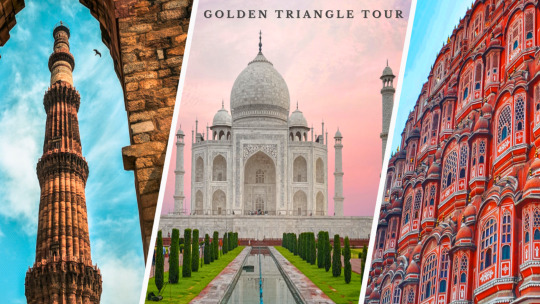
The Golden Triangle Tour, which includes Delhi, Agra, and Jaipur, provides an enthralling look into India's rich history. Every city has a certain allure, from the vibrant marketplaces and historical sites of Delhi to the famous Taj Mahal in Agra and the royal palaces of Jaipur. Let's examine the main features of every location.
Delhi – Capital City Extravaganza
Delhi, the capital city, showcases a perfect blend of the old and the new. From the historic Red Fort and Jama Masjid to the modern architecture of India Gate and Lotus Temple, Delhi is a city that resonates with the echoes of centuries past.
Agra – Home of the Taj Mahal
Agra, with its timeless beauty, is synonymous with the majestic Taj Mahal. Attracting millions of tourists annually, this UNESCO World Heritage Site serves as an enduring emblem of love. Adding to the city's historical charm are the Agra Fort and Fatehpur Sikri.
Jaipur – The Pink City's Royal Grandeur
Jaipur, the Pink City, is a regal destination that boasts of stunning palaces, forts, and vibrant markets. Architectural wonders like the Hawa Mahal, City Palace, and Amer Fort take tourists back to the Rajput dynasty.
Adding Spiritual Bliss: Temple Circuit in the Golden Triangle
Beyond the architectural wonders, the Golden Triangle Tour also unveils the spiritual side of India with its numerous temples. The journey is made more calm by the temple circuit, which connects historic shrines with cutting-edge wonders.
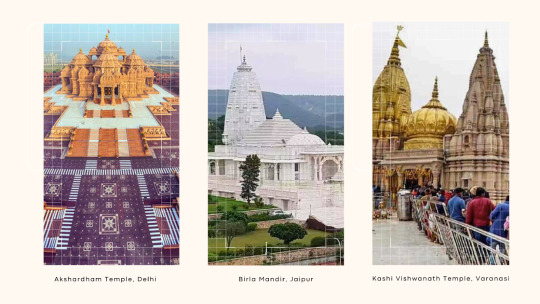
Akshardham Temple, Delhi
In honor of Lord Swaminarayan, the modern architectural marvel Akshardham Temple is located in Delhi. The intricately carved temple complex reflects India's rich spiritual heritage and cultural diversity.
Birla Mandir, Jaipur
The Birla Mandir in Jaipur is a stunning temple devoted to Lord Vishnu and Goddess Lakshmi, and it is located at the foot of Moti Dungari. The elaborate carvings and marble facade of the temple provide a serene haven amidst the bustle of the city.
Kashi Vishwanath Temple, Varanasi
The spiritual center of India, Varanasi, must be visited as an extension of the Golden Triangle Tour. One of the holiest temples in Hinduism is the Kashi Vishwanath Temple, which is devoted to Lord Shiva. The spiritual journey gains a divine touch from the Ganga Aarti held at the Ghats.
Varanasi: A Divine Detour in the Golden Triangle Tour

By adding Varanasi to your Golden Triangle Tour itinerary, you can enter a mysterious and spiritual world. Located on the banks of the holy Ganges River, the city is a center of pilgrimage and culture.
Ganga Aarti at Dashashwamedh Ghat

Varanasi is renowned for its mesmerizing Ganga Aarti, a ritual performed at the Dashashwamedh Ghat. It feels unearthly, with the sound of incense, the sight of floating lamps in the Ganges, and the rhythmic chants.
Sarnath – Where Buddha Preached
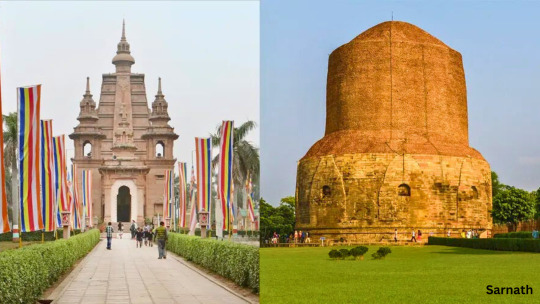
A short distance from Varanasi lies Sarnath, where Lord Buddha delivered his first sermon. The Dhamek Stupa and the Ashoka Pillar stand as testaments to the city's significance in Buddhism.
Conclusion: Embarking on the Golden Triangle Tour, enriched with the spiritual odyssey of Varanasi, is an odyssey through India's soul. This trip offers visitors a comprehensive understanding of India's rich cultural tapestry by skillfully fusing the historical wonders of Delhi, Agra, and Jaipur with the spiritual essence of Varanasi. The Golden Triangle Tour with Varanasi promises an incredible journey into the heart of India, regardless of your interests—history buff, architecture admirer, or seeker of enlightenment on a spiritual level.
#golden triangle package#golden triangle tour#india tourism#golden triangle holidays#holiday package#india trip#tourism#tour and travel#Temple Tour
0 notes
Text
Shri Venkateshwara University, organized an All India Kavi Sammelan during the historic Ganga Fair.



















Shri Venkateshwara University, VGI Meerut, organized an All India Kavi Sammelan during the historic Ganga Fair.
In the Ganga Fair, the DM Mr. Rajesh Kumar Tyagi, SP Mr. Kunwar Anupam Singh, CDO Mr. Ashwini Mishra, Fair Officer Mayashankar & the Pro Chancellor Dr Rajiv Tyagi felicitated the poets which occurred on the Constitution day.
The dignitaries honored the poets by tying a turban, gifting them the Constitution copy & the Ashoka emblem.
The event also saw the participation of teacher MLC Dr Hari Singh Dhillon, sitting MLA Kamal Malik, ADM, SDM, CMO & over two dozen administrative & public representatives that made the Kavi Sammelan historic.
The Group Chairman, Dr Sudhir Giri, reiterated religious functions not only showcase faith, but they also foster enthusiasm, joy and national unity.
The cultural ground of the Ganga Fair was the venue of the All India Kavi Sammelan. The Renowned poet from Faridabad, Mr. Dinesh Raghuvanshi, inaugurated the Kavi Sammelan by paying tributes to the 5 martyred soldiers in J & K.
He dedicated his poetry to the brave soldiers who gave their life for the nation.
Similarly Famous poet of Shringaar Rasa, Ms. Anamika Jain Amber, mesmerized the audience with her heart touching poetry that was admired by all.
Likewise, laughter challenge champion Mr. Pratap Faujdar directed his poetry on the former PM, which made the gathering burst into giggles.
Similarly, Ms. Sapna Soni from Dausa Rajasthan captivated the audience with her Shringaar Rasa poetry, that was the talk of the town.
Dr Dinesh Raghvanshi, poet Anamika Jain Amber, Laughter Poet Pratap Faujdar, Yash Bharti awardee Dr Sarita Sharma, poet Sapna Soni, the great satire poet, Sarvesh Asthana, & Anil Anal entertained the gathering till 4.00 am.
The All India Kavi Sammelan organized by Venkateshwara Group also saw the participation from well-known poets like Dr Praveen Rahi, Kashish Muradabadi, & Rahul Sharma among others.
Those present included the CMO Dr SP Singh, Chief Advisor of the Venkateshwara Group Dr VPS Arora, CEO Mr. Ajay Shrivastava, VC Dr Rakesh Yadav, Registrar Dr Piyush Pandey & Arun Goswami.
Also present were SS Baghel, Gurdayal Singh & others.
We recognize the attendance of Dr. Pratap Singh, the Meerut Campus Director and Mr. Vishwas Rana, the Media Incharge, among other attendees.
0 notes
Text
Air Chief Reveals New Ensign During Air Force Day Parade in Prayagraj
Air Force Day Parade Marks Historic Unveiling of IAF’s New Ensign
In a momentous occasion on Sunday during the annual Air Force Day parade in Prayagraj, Air Chief Marshal VR Chaudhari of the Indian Air Force (IAF) unveiled the new ensign of the Air Force. The IAF had not performed an exercise of this nature in the previous 72 years.
The IAF’s activity comes over a year after the Naval force refreshed its ensign to shed its frontier legacy. The Indian Flying corps peak will be situated in the upper right corner of the new banner.

The Indian Air Force was formally established on October 8, 1932. The prefix “Royal” was given to the force in March 1945 in honour of its professional success and victories during World War II. The outcome was the Royal Indian Air Force (RIAF).
As India became a republic in 1950, the IAF removed its “Royal” prefix and changed the emblem.
IAF’s New Ensign: Symbolizing Values and Heritage
The Union Jack appeared in the top left canton of the RIAF flag, while the RIAF roundel (red, white, and blue) appeared on the fly side. After India gained its independence, the Union Jack was replaced with the Indian tricolour, and the RAF roundels in the lower right canton were swapped out for the IAF tricolour roundel.
“A new Indian Air Force ensign has been developed to better represent the IAF’s principles. The Air Force Crest will now be present in the upper right corner of the ensign, on the fly side, to symbolise this reaffirmation,” the IAF stated in a statement.
The words “Satyameva Jayate” are written in Devanagari beneath the national emblem of the IAF, the Ashoka lion. A Himalayan eagle with its wings wide, representing the combat might of the IAF, is shown underneath the Ashoka lion.
0 notes